The Secret to Great Garden Containers: Thrillers, Fillers, and Spillers
Here’s a simple recipe for eye-catching pots
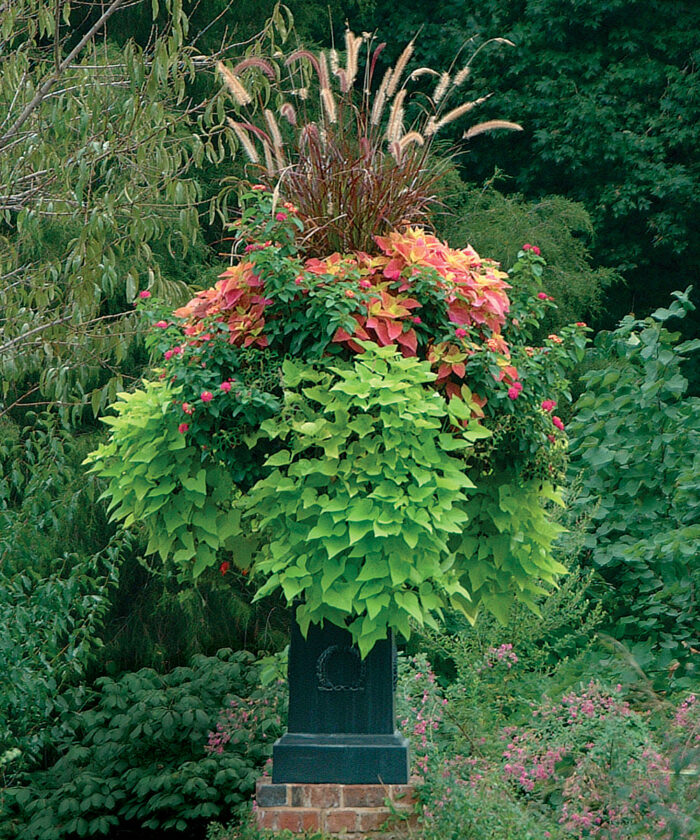
For a lush container that is sure to dazzle, use three types of plants that perform different functions but work in harmony.
One of my favorite garden pastimes is cooking up new ideas for planting containers. I’ve never bothered to count just how many pots I plant each year, but the number easily tops 100.
But no matter how many pots I display, I’ve come to realize there’s no mystery in making a scrumptious container planting as long as I follow a simple three-ingredient recipe. First and foremost is what I call a “thriller,” a centerpiece plant with star quality, something big, bold, and beautiful. Then I add a few spicy “fillers,” foliage or flowering plants that will complement but not overwhelm the main player. Finally, I add a savory splash of mischief, a “spiller” that just tumbles out of the pot. As long as I use each of those kinds of plants—in various proportions—and take care to balance colors and textures, I can create a pot with pizzazz.
Thrillers are the star
As the name implies, thrillers are the big, attention-getting star players. They are usually tall, upright plants, with outstanding qualities—such as colorful foliage, intriguing shape, or dramatic flowers—that last all season long. Many thrillers are architectural: plants with structural, eye-catching form that can serve as a sturdy backbone or rugged framework for a scrim of less substantial plants. Think of the boldly colorful, paddlelike leaves of Canna ‘Pretoria’ or the bright spikes of Yucca filamentosa ‘Gold Edge’.
Thrillers work best in compositions where they are the tallest plant. For me, they are also the starting point in a container design. I select my thriller, then build around it. At planting time, the thriller goes in the center of a pot that will be viewed from all sides or at the back of a pot that will be displayed in a corner or against a wall.
More great thrillers
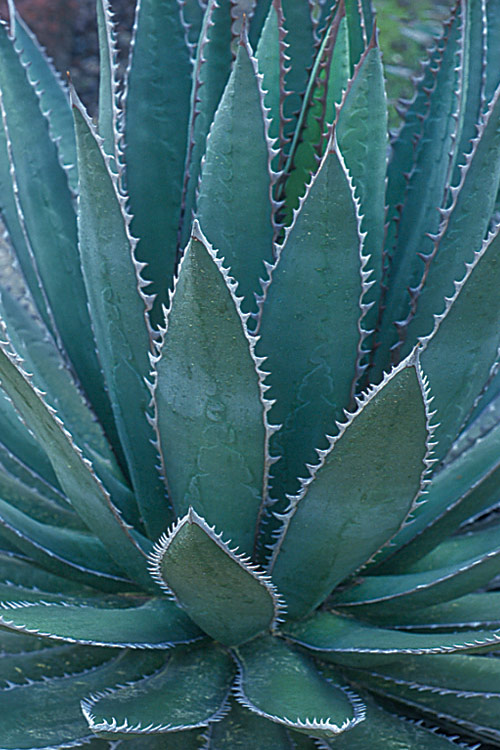 |
 |
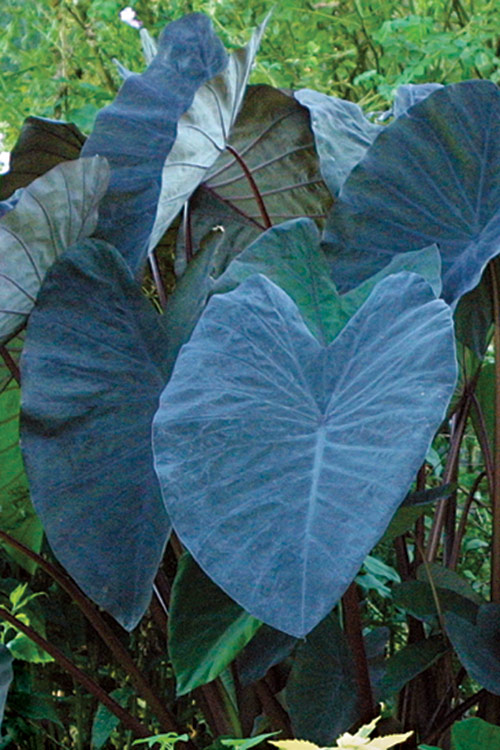 |
- Agaves (Agave spp. and cvs., Zones 11)
- Bananas (Musa spp. and cvs., Zones 8–11; Ensete ventricosum ‘Maurelii’, Zones 11)
- Cannas (Canna ‘Pretoria’, ‘Tropicanna’, and ‘Black Knight’, Zones 8–11)
- Purple fountain grass (Pennisetum setaceum ‘Rubrum’, Zones 9–10)
- Taros (Colocasia esculenta and cvs., Zones 9–11)
Fillers add mass
Next, I add the fillers—billowy, more finely textured plants that surround and weave through the thriller. Fillers add mass to the overall composition and, more important, establish a dialogue with the thriller. Fillers add a textural contrast or colorful counterpoint. In a monochromatic composition, they may simply echo the thriller, though with less saturated color or at a reduced scale. Texturally, I might use a round-leaved filler with a spiky thriller. Since fillers are usually plants with a mounded silhouette, they also do just what the name implies: They fill up the pot while embracing the thriller. Often, they help by hiding the bare knees—the less interesting stems or stalks—of their larger neighbor.
When planting a pot, I position my fillers around the thriller. I often use a mix of plants for this job: some with foliar interest, others with flowers. For flowery fillers, I avoid perennial varieties in favor of uncommon, striking annuals or tender perennials for their much longer flowering season. Since the goal of container plants is to attract the eye, these plants add an alluring unusual flavor. I like bountiful-looking containers, so I cram in as many fillers as I can.
More great fillers
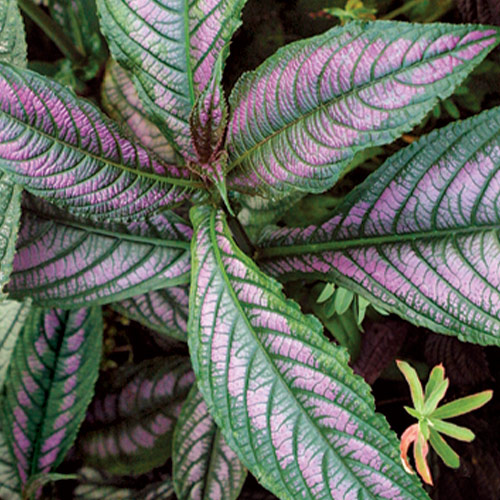 |
 |
For foliar interest
- Begonias (Begonia spp. and cvs., annual)
- Coleus (Solenostemon scutellarioides cvs., annual)
- Dusty miller (Centaurea cineraria ‘Colchester White’, Zones 7–9)
- Persian shield (Strobilanthes dyerianus, annual)
- Plectranthus (Plectranthus spp. and cvs., annual)
 |
 |
For floral interest
- Angelonia (Angelonia angustifolia and cvs., Zones 9–10)
- Cupheas (Cuphea spp. and cvs., annual)
- Fairy fan-flower (Scaevola aemula ‘Blue Wonder’, annual)
- Heliotropes (Heliotropium arborescens and cvs., annual)
- Lantanas (Lantana camara cvs., annual)
- Pentas (Pentas spp. and cvs., annual)
- Trailing petunias (Calibrachoa cvs., Zones 8–11)
 |
 |
Spillers anchor the pot
I often have just enough room left to shoehorn in a few spillers toward the edge of the pot. Sometimes it’s fun to unify a composition by training a few tendrils of a spiller to climb into and through both the filler and the thriller. The main role of a spiller, however, is to sprawl over the side of the container, softening its edges and tumbling toward the ground. When parts of a container planting touch the earth, the pot looks rooted to its place.
But spillers should do more than soften a pot and link it to its place. Well-chosen spillers continue the dialogue begun by the thriller and filler. To deepen that conversation, I look for spillers that echo or contrast with the pot’s other plants by virtue of shape, color, or texture.
More great spillers
 |
 |
 |
- Alternantheras (Alternanthera spp. and cvs., annual)
- Bacopas (Sutera spp. and cvs., annual)
- Golden creeping Jenny (Lysimachia nummularia ‘Aurea’, Zones 4–8)
- Nasturtiums (Tropaeoleum spp. and cvs., annual)
- Sweet potato vines (Ipomoea batatas cvs., Zones 9–11)
Each plant plays a role
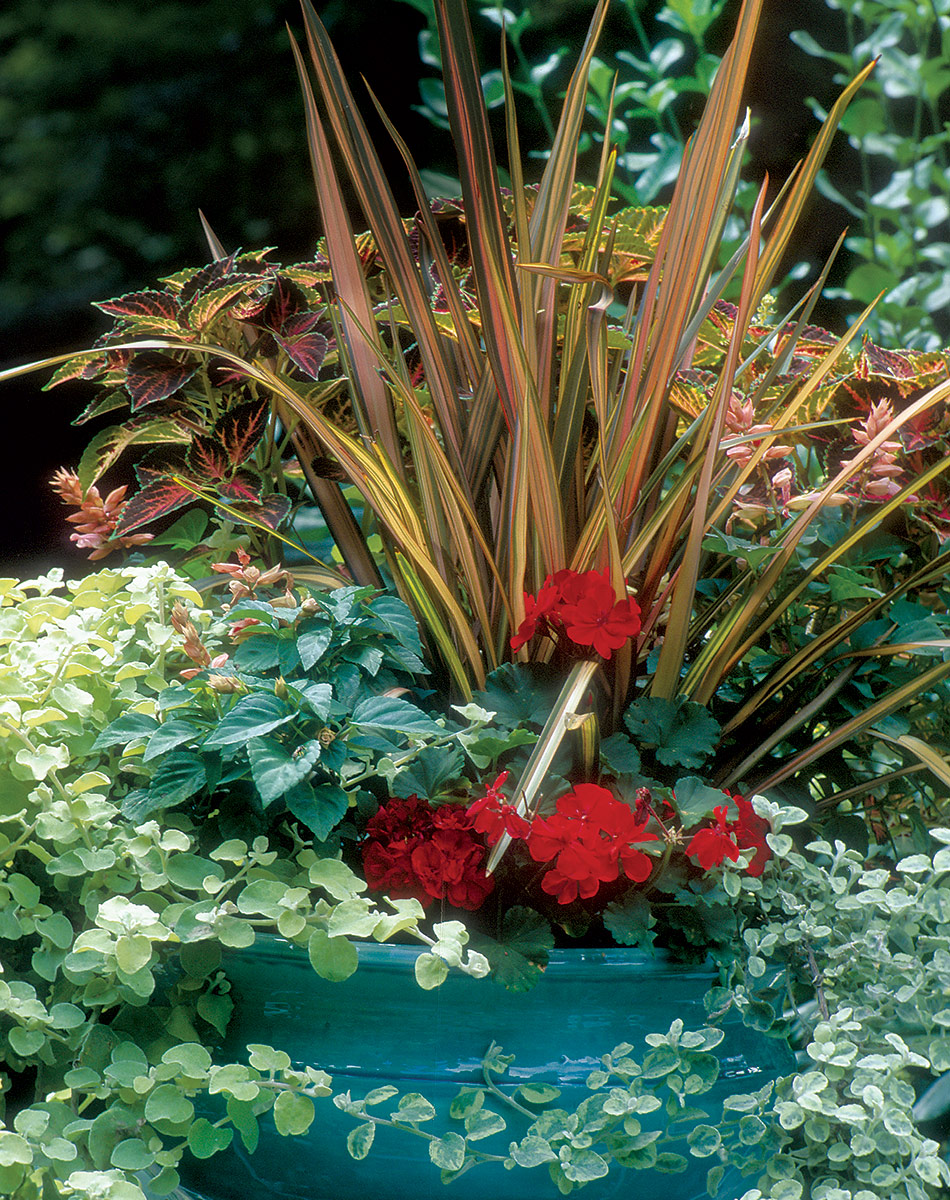
The photo at right is a good example of a well-balanced container planting. Thrillers like this New Zealand flax (Phormium cookianum ‘Maori Sunrise’, USDA Hardiness Zones 9–10) are the highlight of the container and are often where ideas originate.
As a filler, salvia (Salvia splendens cv., annual) is doing what any good sidekick should do: make the hero—the thriller—look good.
A good spiller like licorice plant (Helichrysum petiolare ‘Variegatum’, Zones 10–11) can end up being a mini-thriller, just growing down instead of up.
Keep scale in mind
Planting the right combination of thrillers, fillers, and spillers creates a lush, intriguing composition rich in color, texture, and form. It fills out a pot by exploiting space in every available direction—up, down, and sideways. When selecting plants, I also consider the element of scale. Though I often aim for extreme contrasts in terms of color combination, texture, and shape, I like to use plants more closely related in size. I usually try to group plants using fillers that are roughly between one-third and two-thirds the size of the thriller.
I also bear in mind that the boundaries between my three basic plant types aren’t fixed. Depending on the arrangement and scale of a planting, some fillers might get promoted to thriller, some fillers—many kinds of verbena, for example—might spill a little, and some thrillers might serve as fillers when paired with something larger and even more exotic. But it’s not necessary to overthink the process. No matter what the specific plant, using a thriller, a filler, and a spiller is a sure recipe for success.
Steve Silk is a contributing editor whose hundreds of containers surround his home in Farmington, Conn.
Photos, except where noted: Jennifer Benner
Fine Gardening Recommended Products

Planting in a Post-Wild World: Designing Plant Communities for Resilient Landscapes
Fine Gardening receives a commission for items purchased through links on this site, including Amazon Associates and other affiliate advertising programs.
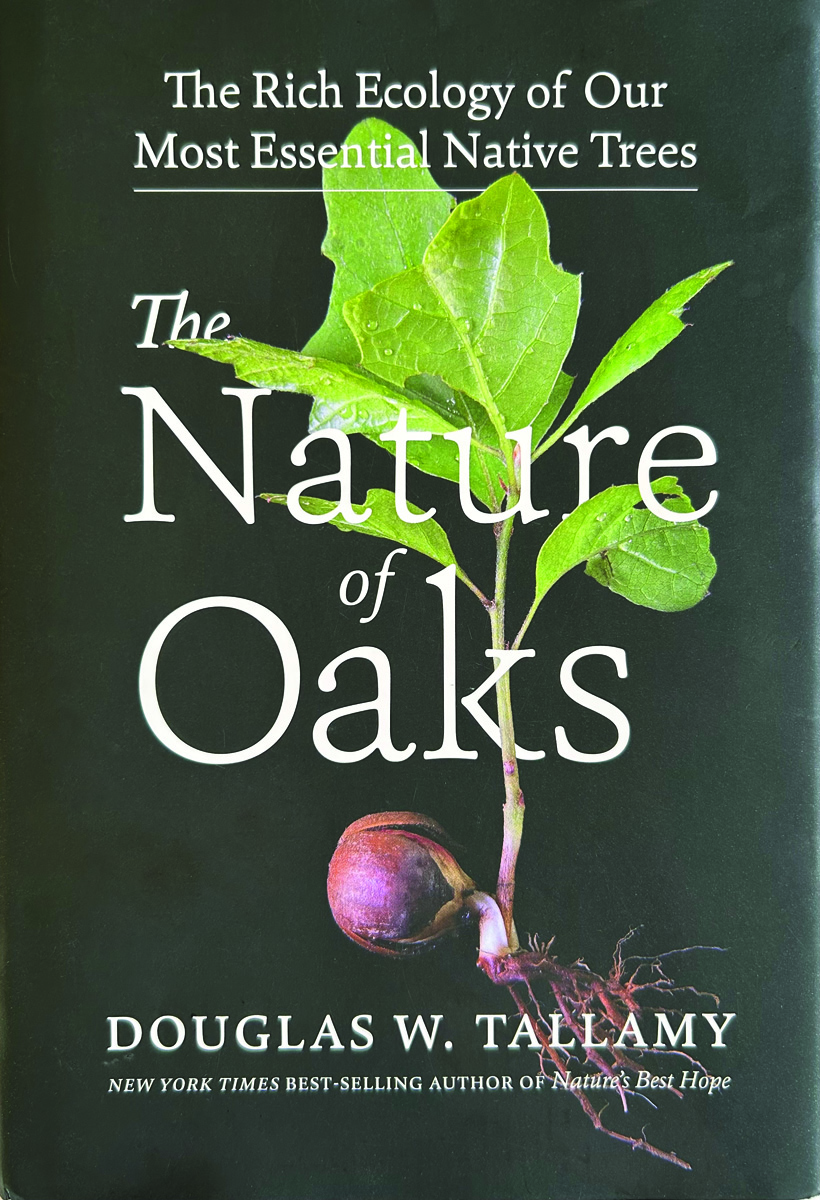
The Nature of Oaks: The Rich Ecology of Our Most Essential Native Trees
Fine Gardening receives a commission for items purchased through links on this site, including Amazon Associates and other affiliate advertising programs.
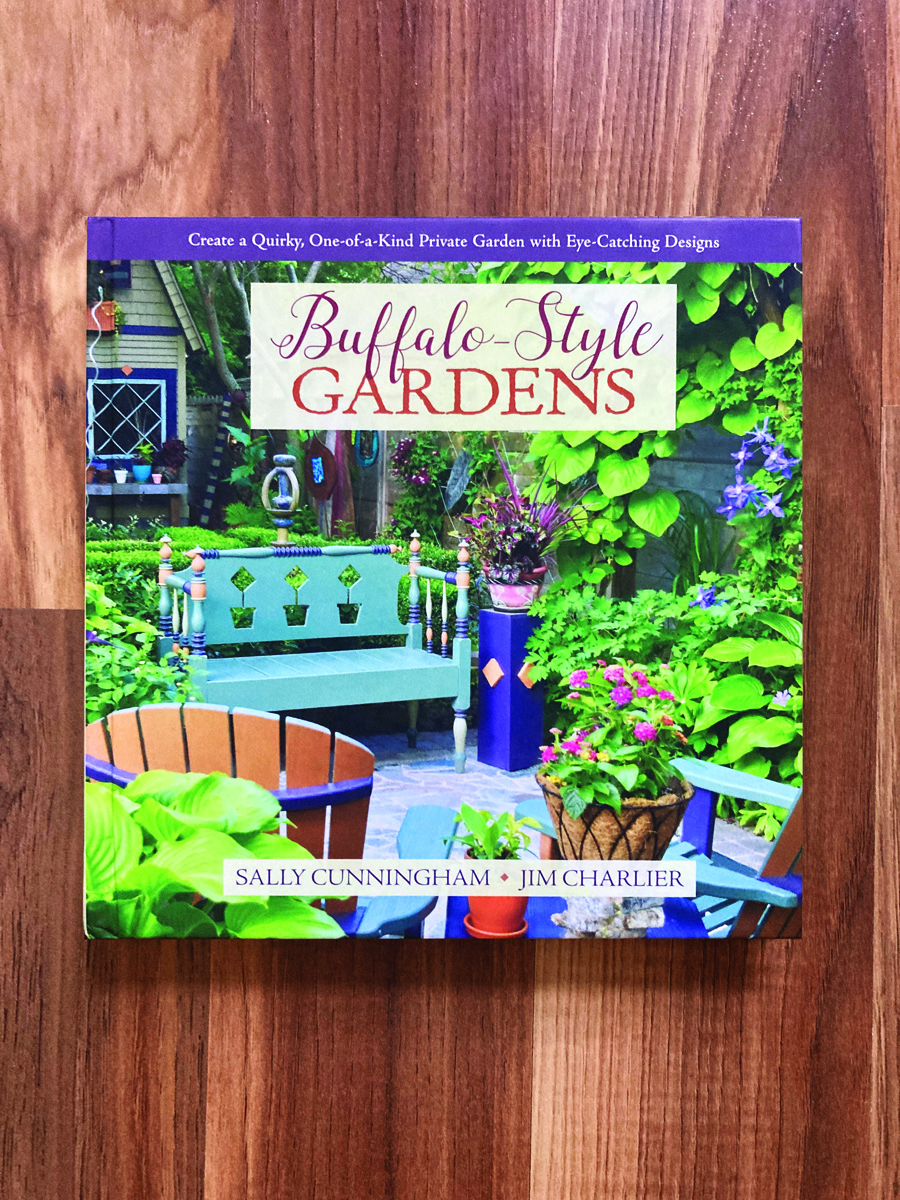
Buffalo-Style Gardens: Create a Quirky, One-of-a-Kind Private Garden with Eye-Catching Designs
Fine Gardening receives a commission for items purchased through links on this site, including Amazon Associates and other affiliate advertising programs.

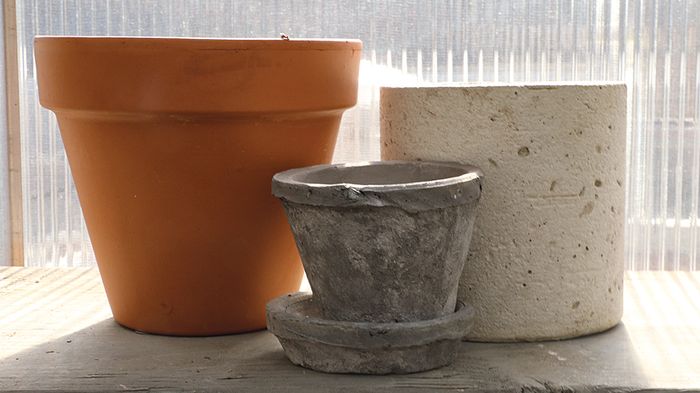







Comments
You have some great suggestions. I have been doing basic petunia hanging baskets for quite some time, but this year I'm working hard to create something vital and new and exciting! I didn't realize how much mental WORK goes into the process though! Not only do I have to decide what to buy, but finding places that carry everything I am looking for or running from nursery to nursery! And, then coming home and asking myself "I bought THIS plant to go with WHICH other plants???" WOW! I'm already tired and haven't planted a thing yet!
BUT...gardening (even mental gardening) tired is one of my favorite things to be!
I agree with you, Sally. Or I have a plan in mind but when I get to the garden center I get sidetracked by all the plants and start deviating from the plan. When I get home I too wonder what goes with what!
Thank you for putting this information together. As logical as it is, I have spent years buying plants that I didn't have a plan for or getting home without one of the needed elements!
I am getting tired of being told that THE way to have lovely potted plants is to follow a recipe. Yes, it can look good to have the thriller, spiller, filler plan for SOME of our pots, but I think it's old-school to be told the same old formula year after year by so-called "experts" and make us feel as if we've failed if we don't go by the old formula. They seem to forget nature itself is quite random and that randomness is beautiful.
It's perfectly fine to just go with what feels right, what we think looks pretty, a total random planting, or what WE imagine for a specific area and toss the "rules" out the window.
I'd like to see a few "experts" admit that the given formula isn't the be-all-end-all way to create beautiful potted plantings instead of constantly rehashing the same old mantra.
It's Great
Very nice!
Log in or create an account to post a comment.
Sign up Log in